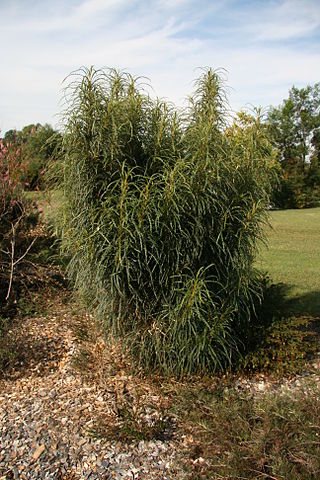Banksia cypholoba is a species of dwarf, prostrate shrub that is endemic to Western Australia. It has pinnatipartite leaves with twenty-five to forty triangular lobes on each side, heads of about sixty brownish and yellow flowers and mostly glabrous follicles.

Banksia drummondii, commonly known as Drummond's dryandra, is a species of shrub that is endemic to Western Australia. It has pinnatifid to pinnatisect leaves, heads of up to one hundred cream-coloured, red and yellow flowers and glabrous fruit.
Banksia fasciculata is a species of column-shaped shrub that is endemic to Western Australia. It has hairy stems, crowded, prickly leaves, yellow flowers and hairy fruit.
Banksia fililoba is a species of shrub that is endemic to Western Australia. It has pinnatipartite leaves with sharply pointed lobes, heads of up to eighty yellowish flowers and egg-shaped fruit. It mainly grows in kwongan in the south-west of the state.
Banksia fuscobractea, commonly known as the dark-bract banksia, is a species of shrub that is endemic to a small area in the south-west of Western Australia. It has prickly, serrated, wedge-shaped leaves, pale yellow and cream-coloured flowers in heads of up to almost two hundred, and three or four egg-shaped follicles in each head.

Banksia hirta is a species of shrub that is endemic to Western Australia. It has hairy stems, deeply serrated leaves, pale yellow flowers in heads of about one hundred and shining follicles. It is restricted to the Stirling Range National Park.
Banksia ionthocarpa is a species of shrub that is endemic to Western Australia. It has short, hairy, prostrate stems, pinnatifid leaves, pinkish purple to orange flower in heads of between forty and sixty at the base of leaves, and egg-shaped follicles with a distinctive tuft of hairs on the end.
Banksia lepidorhiza is a species of prostrate shrub that is endemic to Western Australia. It has underground stems, linear pinnatipartite leaves with sharply pointed lobes, pink, cream-coloured and yellow flowers in head of about thirty and egg-shaped follicles. It is only known from near Woodanilling.

Banksia dallanneyi, commonly known as couch honeypot, is a species of prostrate shrub that is endemic to Western Australia. It only has a short above-ground stem, pinnatipartite or pinnatisect leaves, between thirty and seventy variously coloured flowers and glabrous, egg-shaped fruit.

Banksia prolata is a species of bushy shrub that is endemic to Western Australia. It has linear, serrated or pinnatifid leaves, yellow flowers in heads of between 150 and 250, and egg-shaped follicles.
Banksia meganotia is a species of prickly shrub that is endemic to Western Australia. It has linear, pinnatiparite leaves with sharply-pointed lobes, yellow flowers in heads of about forty and relatively small follicles.
Banksia montana, commonly known as the Stirling Range dryandra, is a species of shrub that is endemic to the Stirling Range in Western Australia. It has hairy stems, linear pinnatisect leaves with twisted, triangular lobes, yellow flowers in heads of about sixty and reddish-brown follicles.
Banksia pallida is a species of column-shaped shrub that is endemic to the south-west of Western Australia. It has densely hairy stems, linear leaves with three to five serrations on each side, pale yellow flowers in heads of up to eighty and egg-shaped to elliptical follicles.
Banksia platycarpa is a species of small shrub that is endemic to the south-west of Western Australia. It has broadly linear pinnatipartite leaves, with up to twenty-five sharply pointed lobes on each side, creamy-yellow to orange flowers in heads of up to seventy-five, and egg-shaped follicles.
Banksia plumosa is a species of shrub that is endemic to Western Australia. It has hairy stems, broadly linear pinnatifid to pinnatipartite leaves with triangular lobes, creamy-yellow flowers in heads of up to eighty, and egg-shaped follicles.
Banksia porrecta is a species of prostrate shrub that is endemic to the south-west of Western Australia. It has hairy, underground stems, pinnatipartite leaves with up to forty narrow triangular lobes on each side, yellow flowers in heads of between twenty and thirty, and one or two egg-shaped follicles in each head.

Banksia serratuloides is a species of small shrub that is endemic to Western Australia. It has linear, pinnatipartite leaves, yellow and pink flowers in heads of about forty and hairy, wrinkled follicles.
Banksia shanklandiorum is a species of dense shrub that is endemic to Western Australia. It has hairy stems, pinnatipartite to pinnatisect leaves with sharply-pointed lobes, pink to gold-coloured flowers in heads of about 100, and egg-shaped follicles.

Banksia stenoprion is a species of prostrate shrub that is endemic to the south-west of Western Australia. It has short, underground stems, pinnatisect leaves with triangular lobes, golden, mauve or purple flowers in heads of up to ninety, and egg-shaped follicles.

Banksia tenuis is a species of shrub that is endemic to the southwest of Western Australia. It has pinnatifid, serrated or smooth-edges leaves, golden brown and cream-coloured flowers in heads of about fifty-five and glabrous, egg-shaped follicles.









